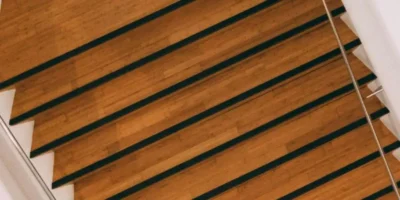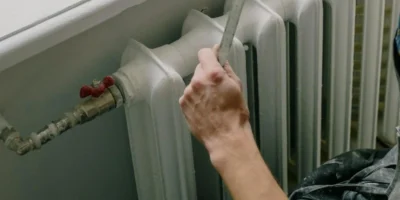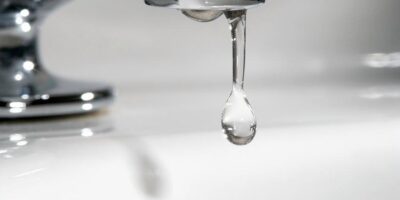When renovating the bathroom or kitchen, knocking off the old tiles will make noise, dust and work. It is also easier. But you can renovate a bathroom easily with out doing that.
It’s not even the cost alone that keeps us from redesigning the bathroom. Rather, one thinks with horror of the dirt and the noise that is caused by the knocking off of the old tiles. Frequently, these wall coverings have also been laid in the thick bed process, so that after the knocking the installation surface must be completely repainted.
But there is the possibility to leave the old tiles and glue new ones to the old ones. In kitchen installations, where only a tile shield remains between the fitted wardrobes, this procedure is common. It can be used in the bathroom as well.
Nevertheless, one has the opportunity to improve the comfort of the bathroom by installing more modern or other sanitary elements. In this bath we relocated the heating, renewed the fittings and covered the old tiles.
Renovate a bathroom easily: The right planning
Before you start with the reconstruction measures, think about what should be changed. Since the wall is completely redone, the sanitary elements could also be rearranged on this occasion. Most of the old baths were tiled only slightly up the middle of the wall. It’s no problem tiling up higher.
However, in bathrooms it is not always advisable to dress up to the ceiling. The normally plastered wall absorbs the excess water vapor best and releases it later at low humidity. It can be very useful to dress the wall only up to the door or window height. Then the wall on the shower is also sufficiently protected against splashing water .
When choosing the tiles you should look for the thinnest possible slabs. For too strong tiles would z. B. the bath paneling previously be freed from the old tile floor. If you tell the seller when buying tiles that tile should be laid on tile , you will surely get the right offer.
Tiles are a very durable wall covering. The desire for a renovation of the bathroom is usually not because the tiles are worn, but because they do not like because they have become outmoded . The new tiles should be selected from the point of view that they will meet the demands tomorrow.
Renovate a bathroom easily: The preparatory work
The preparatory work begins with balancing the transition of the old tiles to the wall, when the new tile sign should be higher. Wallpapers and non-bearing paints must first be completely removed , since neither the repair mortar nor the tile adhesive can adhere to these surfaces. Then the transition is compensated with a cement mortar over such a large area that no heels can arise.
The old tile floor must be thoroughly cleaned . Over the years, a coating of soap and lime residues has formed. The surface is scrubbed vigorously with a scouring agent. The limescale residue can be removed most effectively with a cleaning vinegar (vinegar essence). Strong chemical agents are not essential.
In order to improve the adhesion of the new tiling even further, the surface can be sanded with sandpaper. A small angle grinder does the best service here. During this work you will also notice where there are any bumps that need repairing.
If you want to be sure, you can pick the glaze of the old tiles with a tile hammer. Instead of mechanically roughening the old tiles, you can also apply a very thin layer of tile adhesive and allow to dry to improve adhesion before the actual gluing .
Then the tiles are laid. The butt joint between old tiles and the leveling plaster of the wall must be bridged with a fabric filling. This avoids the formation of cracks in this area. The heating niche under the window was closed with a construction of slats and plasterboard, the heating was relocated.
Ready-to-use glue
The plasterboard must be primed before tiling when you renovate a bathroom easily. The joints between the masonry and the plasterboard must be covered with a reinforcing mesh. The laying surface must be absolutely even, as the dispersion adhesive is applied only thinly and a maximum of 1 mm unevenness can be compensated.
The joint course of the old tile covering must not be taken over for the new tiles, as otherwise cracking may occur in the joint. The areas must therefore be re-classified, which in this example results anyway due to the different tile format.
If vertical and horizontal are correct, which is checked with plumb bob and spirit level, one can orient oneself at the marking of the surfaces at these lines. The location of the decorative tiles and the surrounding border are marked.
For laying the wall tiles, a ready-to-use dispersion adhesive is used, ie it does not need to be smelted. The adhesive is applied thinly on the laying surface and combed through well. On the upper row of tiles should be combed horizontally, so that no condensation can pull behind the tiles.
The surrounding border is striking as a design element. It is therefore placed over the entire wall surface when about half of the wall is completely tiled. Because of the particularly important dimensional accuracy is worked with the tile witch .
Then you move first the lower, then the upper part of the wall. The places where the decorative tiles are to be set are left blank. They are finally glued. The open time for this dispersion adhesive, ie the time that the adhesive stays wet after combing, is 30 minutes , just as with the adhesive mortars .
Despite immediate adhesion of the tiles corrections are still possible for a short time. Glue residues must be wiped off immediately with a damp cloth. Incidentally, dispersion adhesive can also be used for the floor covering. To increase the final strength, however, then cement must be added. The wall surfaces can be grouted after 48 hours at the earliest.
This is additionally needed when laying the tile on tile:
Household cleaners , scouring agents and vinegar essence are kept ready for cleaning the old tile covering in sufficient quantities. With a single-handed sander or an orbital sander , the old coating can be sanded to improve the adhesion of the substrate.
The transition from the old tiles to the wall when yo renovate a bathroom easily is compensated with a repair mortar, which should dry as quickly as possible. The seam is covered with a reinforcing fabric, which can also be used to cover cracks in the wall, and filled with tile adhesive.

The knocking off of the old tiles would be associated with a lot of effort , especially as they were still laid in the thick bed process.

The adhesion of the new tiling is improved when the old tiles are sanded with sandpaper .

The wall will be tiled up to the ceiling during this renovation. Wallpapers and paints must be removed beforehand.

The transition from the old tiles to the new plaster is covered with a fabric that is pressed into the cement.

The substrate for the new tiles is prepared. The course of the border is marked on the wall.

The tile adhesive is applied very thinly in this type of tile laying. The teeth of the spatula arecorrespondingly fine .

The tiles are pressed into the thin layer of adhesive as in normal laying. The laying surface must be level.

The dimensional accuracy of the horizontal is continuously monitored during work with the tile witch.

The border is set when one half of the wall is tiled and the lower row of tiles is marked.

Tile crosses are helpful to maintain a consistent joint width. The crosses remain in the adhesive bed.

The horizontal is checked with the spirit level before the lower part of the wall is tiled.

Decor tiles will be finalized . If the glue is no longer moist, glue is applied to the back of the tile.

The bathroom is now back to today’s standards, because you worked out how to renovate a bathroom easily. The panel was pulled up to the ceiling. The white tiles were glued to the old blue surface.
 Gerhardt Richter is a writer and a trainer at trade technical colleges, specializing in carpentry, plumbing, mechanics and construction.
Gerhardt Richter is a writer and a trainer at trade technical colleges, specializing in carpentry, plumbing, mechanics and construction.




